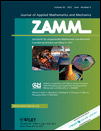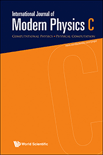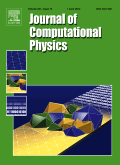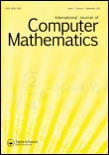
International Journal of Mathematics and Physics
Scope & Guideline
Advancing Knowledge through Collaborative Scholarship
Introduction
Aims and Scopes
- Mathematical Modeling and Analysis:
The journal emphasizes the development and application of mathematical models to solve complex problems in physics and engineering, including numerical simulations and analytical approaches. - Interdisciplinary Research:
Encouraging a blend of mathematics and physics, the journal publishes studies that bridge various fields, such as materials science, fluid dynamics, and cosmology, showcasing the interconnectedness of these disciplines. - Advanced Computational Techniques:
Focus on innovative computational methods for solving differential equations, boundary value problems, and simulations of physical phenomena, highlighting the importance of technology in modern research. - Study of Physical Phenomena:
Research on fundamental physical phenomena, including thermodynamics, quantum mechanics, and cosmology, with an emphasis on both experimental and theoretical perspectives. - Materials Science and Engineering:
Investigation of materials properties and behaviors under various conditions, including radiation effects and thin film technologies, underlining the journal's commitment to applied physics.
Trending and Emerging
- Nanomaterials and Their Applications:
A significant trend is the increasing focus on nanomaterials, particularly in their synthesis, characterization, and application in technology, such as photovoltaics and photoconverters, reflecting the growing interest in nanoscale research. - Complex Systems and Nonlinear Dynamics:
Research on complex systems and nonlinear dynamics is emerging, with studies investigating phenomena such as turbulent combustion and viscoelasticity, indicating a shift towards understanding intricate physical behaviors. - Advanced Computational Methods:
There is a rising trend in the application of advanced computational techniques, including machine learning and artificial intelligence, to address complex physical problems, highlighting the journal's alignment with technological advancements. - Cosmology with Dynamical Models:
The exploration of dynamical cosmological models, particularly those incorporating dark energy and anisotropic fluids, is gaining prominence, showcasing an evolving interest in understanding the universe's structure and evolution. - Thermal and Radiation Effects in Materials Science:
Increasing attention is being paid to the effects of thermal and radiation conditions on material properties, emphasizing the practical applications of physics in engineering and technology sectors.
Declining or Waning
- Classical Mechanics:
Research papers focusing on traditional topics in classical mechanics have become less frequent, indicating a possible shift towards more advanced or applied areas of study, such as quantum mechanics or relativistic physics. - Static Models in Cosmology:
There has been a noticeable decrease in publications centered around static cosmological models, as researchers increasingly explore dynamic and complex frameworks that better capture the universe's evolving nature. - Conventional Experimental Techniques:
Papers discussing conventional experimental methods in physics are declining, possibly due to the rise of computational simulations and advanced technologies that offer more efficient and comprehensive analysis. - Basic Theoretical Physics:
The focus on fundamental theoretical physics concepts appears to be waning, with more emphasis now placed on practical applications and interdisciplinary approaches that integrate mathematical and physical sciences.
Similar Journals

EUROPEAN JOURNAL OF PHYSICS
Advancing the Frontiers of Physics and AstronomyEuropean Journal of Physics, published by IOP Publishing Ltd, is a premier international journal serving the diverse field of physics and astronomy. With a commitment to advancing scientific knowledge since its inception in 1980, the journal provides a platform for original research articles, reviews, and topical discussions in various domains, including theoretical and experimental physics. Operating out of the United Kingdom, the journal has achieved a commendable Q2 ranking in the Physics and Astronomy (miscellaneous) category for 2023, reflecting its robust influence in the academic community, alongside a notable Scopus Rank that underscores its relevance in both the Social Sciences and General Physics and Astronomy fields. Although it does not currently offer open access, the journal's traditional publication model ensures rigorous peer review, maintaining high scholarly standards that are imperative for researchers, professionals, and students striving to stay ahead in their respective fields. Don't miss the opportunity to engage with cutting-edge research and contribute to the ongoing dialogue in physics by accessing this vital resource.

CANADIAN JOURNAL OF PHYSICS
Exploring the universe, one discovery at a time.The Canadian Journal of Physics, with ISSN 0008-4204 and E-ISSN 1208-6045, is a prominent publication in the field of physics, published by Canadian Science Publishing. Established in 1970, this journal serves as a vital platform for disseminating groundbreaking research and innovative findings across a spectrum of topics within physics and astronomy. With a current Q3 ranking in the miscellaneous category and a respectable Scopus rank of 130 out of 243, the journal ranks within the 46th percentile, confirming its relevance and contribution to the scientific community. Researchers, professionals, and students are encouraged to submit their work for consideration in this esteemed journal, which aims to foster scholarly exchange and advance knowledge in the physical sciences. Although the journal operates under a traditional access model, its rich archive and contemporary insights ensure that it remains a critical resource for anyone invested in the dynamics of physics.

Moscow University Mechanics Bulletin
Empowering Ideas in Mathematics and MechanicsMoscow University Mechanics Bulletin, published by PLEIADES PUBLISHING INC, is a dedicated journal that has been influencing the fields of mechanical engineering and mechanics since its inception. With an ISSN of 0027-1330 and E-ISSN of 1934-8452, this journal serves as a crucial platform for advancing knowledge in mathematics, mechanical engineering, and mechanics of materials. Though currently indexed in the Q4 category across these disciplines, it offers a unique space for researchers and professionals to engage with emerging theories, experimental results, and practical applications. With a converged publication history spanning from 1973 to 1987, and continuing from 2007 to 2024, the journal remains relevant in today’s academic landscape. Though it operates under traditional access models, the journal's global reach aims to connect diverse voices in engineering research. Aspiring researchers and seasoned professionals alike will find valuable insights and a robust discourse that contribute to their respective fields.

ZAMM-Zeitschrift fur Angewandte Mathematik und Mechanik
Pioneering Insights in Mathematical Applications for Engineering.ZAMM-Zeitschrift fur Angewandte Mathematik und Mechanik is a distinguished journal published by WILEY-V C H VERLAG GMBH, committed to advancing the fields of applied mathematics and computational mechanics since its inception in 1921. With a significant trajectory spanning nearly a century, this journal serves as a critical platform for the dissemination of high-quality, peer-reviewed research that encompasses theoretical and practical advancements in these disciplines. Currently holding a Q3 category in Applied Mathematics and Q2 in Computational Mechanics as per the 2023 rankings, ZAMM demonstrates its prominence with measurable impact in both fields, reflected in its Scopus rankings: 202 out of 635 journals in Applied Mathematics and 32 out of 89 in Computational Mechanics. Although it does not provide open access, ZAMM remains invaluable to researchers, professionals, and students seeking to deepen their understanding and contribute to the evolving landscape of mathematical applications in engineering contexts. Explore the latest insights and methodologies that push the boundaries of applied mathematics and mechanics by engaging with ZAMM’s comprehensive range of articles.

INTERNATIONAL JOURNAL OF MODERN PHYSICS C
Unveiling Innovations in the Realm of Modern PhysicsINTERNATIONAL JOURNAL OF MODERN PHYSICS C, published by WORLD SCIENTIFIC PUBL CO PTE LTD, is a pivotal platform for disseminating groundbreaking research in the fields of computational theory, mathematical physics, and statistical physics. With an ISSN of 0129-1831 and an E-ISSN of 1793-6586, this esteemed journal, based in Singapore, serves a global audience of researchers and professionals who are dedicated to pushing the boundaries of knowledge in modern physics. The journal's rigorous selection process ensures the inclusion of high-quality articles that advance the understanding and application of complex theoretical concepts. Currently, the journal holds a commendable Q3 quartile ranking across several categories, including Computational Theory and Mathematics and Statistical and Nonlinear Physics, reflecting its influence and relevance in the academic community. Covering a wide array of topics from 1996 to 2024, the INTERNATIONAL JOURNAL OF MODERN PHYSICS C is not just a repository of research; it is a critical resource for students and scholars aiming to stay at the forefront of modern scientific inquiry.

JOURNAL OF COMPUTATIONAL PHYSICS
Pioneering Research in Computational TechniquesJOURNAL OF COMPUTATIONAL PHYSICS, an esteemed publication from ACADEMIC PRESS INC ELSEVIER SCIENCE, serves as a premier platform in the field of computational physics and its interdisciplinary applications. Since its inception in 1966, the journal has provided invaluable insights and significant advancements in areas such as applied mathematics, numerical analysis, and modeling and simulation. With a robust impact factor and ranking in the top quartile across various related categories, including Q1 in Applied Mathematics and Physics and Astronomy, it is essential reading for researchers and professionals aiming to stay at the forefront of computational techniques and methodologies. Although the journal is not open access, it remains highly regarded with a reputation for rigorous peer review and high-quality publications. As the field continues to evolve, the JOURNAL OF COMPUTATIONAL PHYSICS highlights innovative research that not only advances theoretical constructs but also offers practical applications in scientific and engineering domains. For scholars and students, this journal embodies a critical resource for deepening their understanding and fostering dialogue within the scientific community.

INTERNATIONAL JOURNAL OF COMPUTER MATHEMATICS
Elevating Academic Discourse in Applied MathematicsThe International Journal of Computer Mathematics, published by Taylor & Francis Ltd, stands as a prominent forum for the dissemination of novel research in the intersection of mathematics and computing. Established in 1964, this journal has evolved significantly, contributing to the field with robust methodologies and innovative applications. It holds notable rankings within Scopus, classified as Q2 in Applied Mathematics and Q3 in both Computational Theory and Mathematics and Computer Science Applications for 2023, highlighting its pivotal role in advancing academic discourse. Though it is not an open-access journal, its rigorous peer-review process ensures that published articles maintain the highest scholarly standards, making it a reliable source for cutting-edge research. Researchers, professionals, and students alike will find valuable insights and advancements that push the boundaries of mathematical applications in computing, solidifying its importance within the mathematical and computer science communities.

APPLIED MATHEMATICS AND MECHANICS-ENGLISH EDITION
Driving Progress in Engineering through Mathematical RigorApplied Mathematics and Mechanics - English Edition is a prestigious journal published by Shanghai University, focusing on the interdisciplinary applications of mathematics and mechanics across various scientific and engineering domains. With an ISSN of 0253-4827 and an E-ISSN of 1573-2754, this journal has established itself as a vital resource since its inception in 1980, extending its coverage well into 2024. The journal boasts impressive Scopus rankings—placing it in the top 10% of the Applied Mathematics category and the top 20% in Mechanical Engineering and Mechanics of Materials—reflecting its significant impact and contribution to research. Currently categorized in the Q2 and Q1 quartiles, it caters to a diverse audience that includes researchers, professionals, and students seeking to explore cutting-edge developments and innovative methodologies in the field. Although the journal is not open access, it remains committed to disseminating high-quality research that addresses contemporary challenges in applied mathematics and mechanics, fostering a deeper understanding of their practical implications.

TECHNICAL PHYSICS LETTERS
Connecting Innovators in Technical PhysicsTechnical Physics Letters, an esteemed publication of MAIK Nauka/Interperiodica/Springer, serves as a pivotal platform for advancing the field of physics and astronomy since its establishment in 1996. This journal, with its ISSN 1063-7850 and e-ISSN 1090-6533, not only publishes high-quality research articles but also encourages innovative discussions and practical applications within the diverse realms of technical physics. With a solid reputation reflected in its Q3 category ranking within the broader physics and astronomy landscape, it aims to connect researchers and professionals who seek to address contemporary challenges and encourage multidisciplinary approaches to complex scientific problems. Although the journal does not currently offer open access options, it remains accessible to a wide readership, fostering a collaborative spirit among the scientific community. As it converges its efforts from 1996 to 2024, Technical Physics Letters is poised to be an essential resource for anyone looking to stay at the forefront of physics research.

Annals of PDE
Advancing the Frontiers of Partial Differential EquationsThe Annals of PDE, published by SpringerNature, is a premier academic journal dedicated to the field of partial differential equations, encompassing areas such as Analysis, Applied Mathematics, Geometry and Topology, and Mathematical Physics. Since its inception in 2015, the journal has established itself as a vital resource for researchers and professionals seeking to disseminate cutting-edge findings in these rapidly evolving disciplines. With a remarkable Q1 ranking across multiple categories in 2023, including Mathematics and Physics and Astronomy, the Annals of PDE positions itself at the forefront of academic scholarship, as evidenced by its notable Scopus rankings, such as 7th percentile in Geometry and Topology. The journal offers a platform for open access to its articles, making it accessible to a global audience, and fostering collaborative advancements in the understanding and application of partial differential equations. Its contributions are invaluable for advancing theoretical and practical knowledge in mathematics and physics, making it an essential read for students, researchers, and professionals alike.